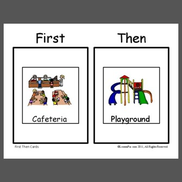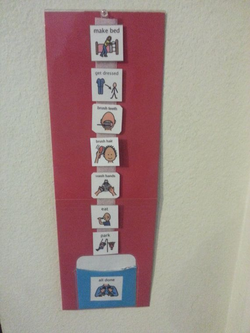What are visual supports?
- traffic lights are visuals to help us know when to go or when to stop;
- grocery lists remind us of things to get at the grocery; and
- we place certain objects by the door to remind us to take it to work the following day. When it comes to children with autism spectrum disorder, visuals help communicate information in a way that is easy for the child to understand.
Two Effective and Popular Visual Supports

Visual Schedule
1. Visual Schedule: A visual schedule is a series of pictures provided in a linear fashion. A simple visual schedule is a First/Then board. This communicates to your child the task/event that must occur before the next task/event can occur. You can use the First/Then board by placing a picture of a nonpreferred activity FIRST and a preferred activity next (THEN). When your child understands the sequencing of the First/Then board, a more complex visual schedule can include an entire day’s events. This communicates to the child the series of events that will be taking place, so the child can anticipate what will occur. If a change occurs in the schedule, it can easily be changed on the visual, so your child is aware of the change.

Choice Boards
2. Choice boards: When providing choices to a child with limited language, it can be helpful to present the objects or picture of the objects to the child for him to physically make a choice. For example, instead of just saying, “Do you want animal crackers or goldfish,” you can ask AND present the two items for him to choose from. A choice board allows for the communicator to present multiple choices at one time.
Remember…
- When you introduce a visual support, it is something new for your child. You will need to teach your child what it is and how it will be used.
- Pair your visual supports with lots of language.
- Make the visual easy to read and use.
- Be consistent and use it across a variety of activities and settings.
Blog written by Jenny Baggett, M.Ed., BCBA